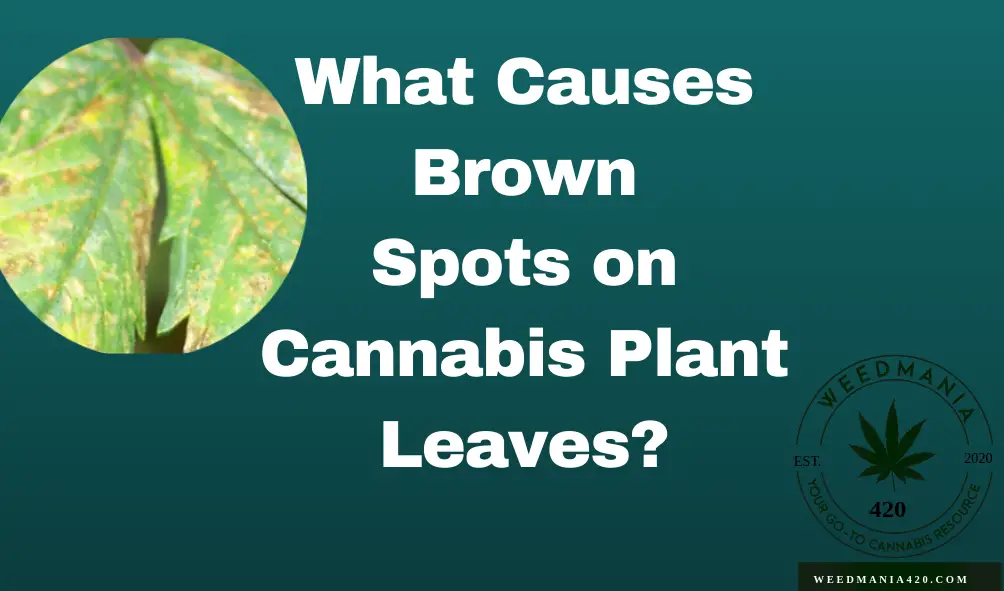Brown spots on cannabis leaves can arise from various deficiencies. This delicate plant can suffer great damage due to a lack of nutrients or poor growth conditions. If your cannabis plant has started developing brown spots, it’s most likely suffering from a nutrient deficiency.
The cannabis leaves should be green and rich in chlorophyll to spur its growth, build its immunity, and assure good health. The brown spots do the opposite— inhibit photosynthesis, deteriorate the plant’s health, slow the plant’s growth, and ultimately reduce your yields.
Table of Contents
What Causes Brown Spots on Cannabis Plant Leaves?
The brown spots on cannabis leaves is caused by a lack of nutrients such as calcium, nitrogen, potassium, manganese, making the cannabis leaves turn yellow and develop brown spots. In extreme cases, the leaves dry up completely, or the plant experiences decreased bud development.
What Do Brown Spots on Plants Mean?
A healthy cannabis plant growing under the right pH balance and with enough nutrients exhibits a green pigment because it’s rich in chlorophyll. The leaves also have trichomes on the surface, giving them a shiny appearance.
While cannabis is a hardy plant, it can only last for so long under less-than-optimum growing conditions. If you notice your leaves are yellowing and developing brown spots, you need to start paying close attention to the nutrients you are feeding your plant. Common causes of yellowing leaves and brown spots include;
Calcium Deficiency
Calcium forms the building ‘cement’ for the cannabis plant. It’s calcium that makes your plant structure sturdy. It helps develop the plant’s walls, stems, branches, root growth and makes your plant resistant to environmental stress. Calcium also helps in the absorption of potassium. As such, it is an essential nutrient that your plants should never lack.
Calcium is a heavy nutrient that moves slowly through the plant. Calcium deficiency will show on new leaves during the rapid vegetative stage. The new leaves may display small brown spots, leaf die-off, stunted growth, spotting, and leaf crinkling.
The plant may also become weak with stems that crack easily and have buds that do not develop fully. In severe cases of calcium deficiency, the plant’s roots may die off completely.
Calcium deficiency occurs when your medium pH is too low. A grow medium with less than 6.2 pH locks out calcium, causing deficiency even if available. If the grow medium has too much potassium, it can also make it difficult for your plants to absorb calcium.
Nitrogen Deficiency
Nitrogen is a vital macronutrient for photosynthesis and chlorophyll production. It also helps your cannabis plants make the amino acids necessary for protein production. This nutrient is also critical during the plant’s vegetative stage.
Cannabis plants suffering from Nitrogen deficiency display yellowing leaves with brown spots at the margins. The leaves also curl up and die off.
On the other end of the spectrum, too much Nitrogen can also cause Nitrogen-toxicity. Cannabis plants suffering from Nitrogen toxicity display a dark green color that appears almost black.
Potassium Deficiency
Potassium deficiency can occur if there is too much Calcium or Nitrogen in your grow medium. This nutrient helps cannabis plants develop a healthy root system. Potassium and Nitrogen work together to protect your plant against fungal infections and pest affliction.
If your cannabis plant is suffering from low Potassium levels, it will display yellowing leaves with brown, rust-colored spots. In extreme cases, the leaf tip and edges dry off and have a scorched appearance.
How Do You Get Rid of Brown Spots on Plants?
The most obvious course of action is to check and balance the grow medium nutrient levels. You can flush the medium with pH balanced water that includes healthy doses of Calcium, Nitrogen, and Potassium.
If you are using supplements, pay close attention to how they work. It helps to talk to an expert so you can understand how much of each nutrient your cannabis plants need. While the affected leaves will not recover, new leaves will not display yellowing or brown spots once you achieve the right nutrient balance.
Pay close attention to new leaves to ensure they grow healthy and adjust your soil nutrient levels as required. You can also check out our article on how to cure Cal-Mag deficiency in your cannabis plant.
Remedying Nutrient Deficiencies in Your Grow Medium
After identifying which nutrient deficiency your cannabis plant is suffering from, you can remedy the problem by adding the required minerals. However, it is not an exact science. If you add too much of one nutrient, your plant will suffer from toxicity or nutrient lock-out.
We recommend using compost or other high-quality organic matter. Adding organic matter to your soil provides better results and adds beneficial microorganisms that break down nutrients keeping them readily available and easier to absorb for your plant.
Should you Always Worry About Yellowing Leaves?
It is perfectly normal for the youngest leaves to turn yellow and fall off. As harvest time approaches, the green leaves that grow during the vegetative stage die off. These leaves, called fan leaves, act as biological solar panels and are a rich addition to your compost material.
Feeding your plants enough nutrients allows them to blossom and grow steadily. Thanks to proper nutrient balance, you will reap big. To remove nutrient deposits in your final product, you flush your plant with pH balanced water. Flushing makes your weed smoother when you smoke it.
In Conclusion
It can be challenging to tell which nutrient is missing if your cannabis plant is displaying multiple signs. The deficiency symptoms are usually very similar, but if you pay close attention to your plant from the beginning, you can spot them fairly quickly.
If you notice the signs, do not go overboard with the treatment. A heavy-handed approach will lead to toxicity or other complex problems. Stay calm and check out our cannabis pests and diseases page to find out what could be ailing your plant.

